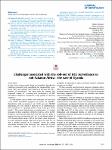Challenges associated with the roll-out of HCC surveillance in sub-Saharan Africa - the case of Uganda
Date
2020Author
Stijn, Van Hees
Muyindike, Winnie
Erem, Geoffrey
Ocama, Ponsianoo
Seremba, Emmanuel
Apiyo, Paska
Michielsen, Peter
Okwir, Mark
Vanwolleghem, Thomas
Metadata
Show full item recordAbstract
In sub-Saharan Africa, where HBV infections are the main
cause of HCC, surveillance programs are mostly not available.2
Nonetheless, with an incidence rate of 8.9 cases per 100,000
inhabitants per year, which is likely to be an underestimate,
HCC surveillance is a pressing medical need in this part of the
world.2,3 The recent introduction of country-wide vaccination
programs in these countries will likely result in a drop in HCC
incidence a few decades from now, but this does not apply to
patients that are currently infected.4 In a recent African cohort of
1,315 hepatocellular tumors, 84% of the tumors were diagnosed
at a late, multifocal disease stage with a mean size of 8 ± 4 cm
and a median survival of 2.5 months.2 Given the strong
association between early detection and improved survival,
these findings highlight the need to set up surveillance
programs in sub-Saharan Africa, provided curative treatment
options are available.1
We have recently launched such a program in Uganda, where
HCC is one of the most common malignancies. Age-standardized
incidence rates of 6.5/100,000 in men and 6.0/100,000 in women
have been reported. Unfortunately, its mortality rate almost
mirrors its incidence.2,5–7
Following a kick-off meeting in Kampala in August 2019
where representatives from the radiology and internal medicine
departments of 5 Ugandan, tertiary care hospitals were present,
a questionnaire was launched among the participants to identify
gaps that needed bridging in order to set up an HCC surveillance
program. Participants were asked about the number of patients
with HBV and HCC in their centers, the availability of alpha fetoprotein and ultrasound testing, as well as the available
manpower to perform ultrasound. A summary of the findings is
displayed in Table 1.
None of the centers had an HCC surveillance program in place.
However, outpatient HBV clinics are available in 3/5 centers and
planned in the fourth. The estimated number of patients fre quenting these HBV clinics varies between <100 and 500–1,000.
Given a nationwide HBsAg seroprevalence of 10% in Uganda,
these varying numbers might point to the regional differences in
HBV-infected patients, but they may also point to variations in
linkage to care.8 Ultrasound machines are widely available in all
centers and except for 2, all were manufactured within the last decade (Table 1). The number of staff trained to perform
ultrasound largely varies between centers, ranging between 1
and 39, but corresponds to a coverage of 87% for the total
number of medical staff at the radiology departments
(radiologists/radiographers). Regular post-graduate training for
ultrasound staff is provided in 3/5 centers. AFP testing is avail able in 2 centers; in a third center testing is offered based on
reagent availability. A registry of the number of HCC cases is
available in 1 center, though survival data are not systematically
recorded.
Diagnosis of HCC is based on clinical signs, such as a palpable
liver mass or liver lesions on ultrasound in patients with clinical
deterioration and not identified during screening of patients at
risk. Liver surgery for non-advanced HCC is available in 1 center.
Our survey highlights the feasibility of rolling out an HCC
surveillance program in Uganda, as manpower, US equipment
and treatment options are available. Further investment should
aim at establishing HBV clinics with optimal linkage to care and
broadening HCC treatment capacities. Our findings may guide
other groups aiming to roll out surveillance programs in different
countries. keywords: Challenges, HCC surveillance, and sub-Saharan Africa
Collections
- Research Articles [17]

